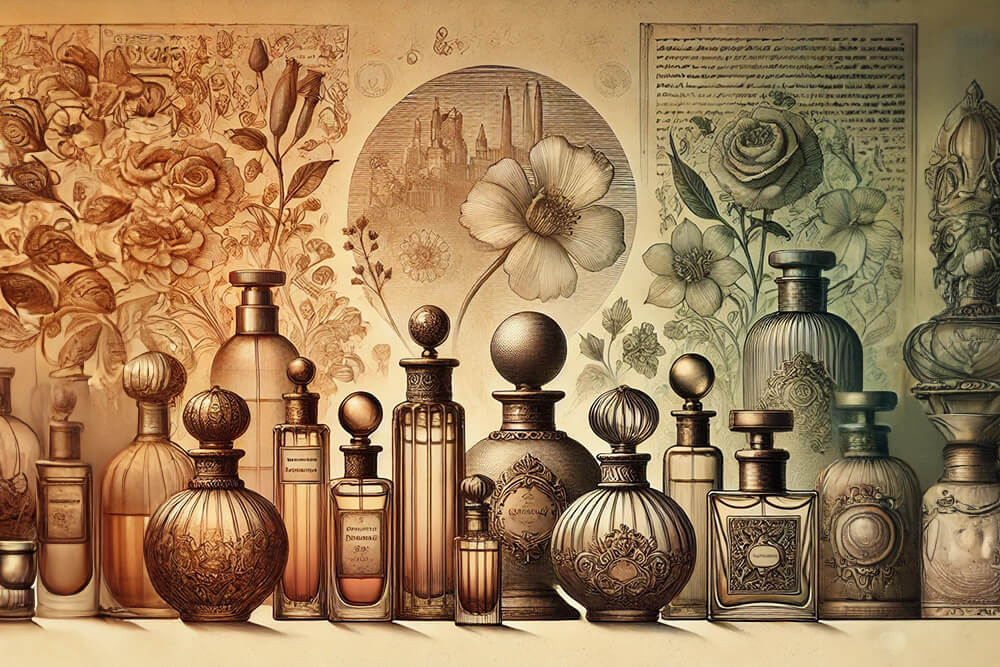
The History of Perfumery - from Ancient Times to the Present
Share
History of Perfumery
The history of perfumery dates back to ancient times, when fragrances were used for various purposes, mostly religious. Initially, resins and plants were burned, releasing fragrant smoke. This is where the name perfume comes from (from the French "par fumée" - "through smoke").
Over the centuries, perfumes became an essential part of social and cultural life, with their development and evolution linked to various eras and historical events. Today, perfumes remain popular and are a significant element of the cosmetics industry.
Ancient Times
The use of fragrances was a common practice in ancient civilizations such as Egypt, Greece, and Rome, serving various purposes, from religious practices to personal hygiene. The variety of techniques and ingredients used in perfumes differed depending on the region and culture.
In Egypt, fragrant oils were made from plants (myrrh, frankincense) and animal-derived substances (musk), while in Greece and Rome, fragrant oils were made from flowers, herbs, and roots. These scents were used in numerous ways, including as offerings to gods, masking unpleasant odors, and enhancing personal beauty. Additionally, they were used in healing practices and as symbols of wealth and status. The art of perfumery was highly valued in these ancient civilizations and remains a significant industry.
Interesting Facts:
- The first evidence of perfume use dates back to Mesopotamia around 4000 BC.
- The Egyptians were among the first to make perfumes a daily part of their lives.
- Queen Cleopatra was known for her use of perfumes, and her scents were famous throughout the ancient world.
- In ancient Greece, perfumes were used by both men and women and were valued for their medicinal properties.
- The Romans developed techniques for distillation and extraction of essential oils. Perfumes were used on a large scale, including scenting baths and clothing.
Middle Ages
In medieval Europe, after the fall of Rome, perfumes became less popular. However, in Arab culture, the art of perfumery flourished. Arab chemists and alchemists, such as Avicenna, refined distillation methods, allowing for more efficient extraction of essential oils.
Interesting Facts:
- In Europe, perfumes returned to popularity during the Crusades when Crusaders brought back oriental scents.
Renaissance and Baroque
During the Renaissance, perfumes became not only a part of daily hygiene but also an art, with perfumers being recognized as artists. With the advancement of chemistry and botany, the techniques and ingredients used in blending fragrances became more sophisticated. Perfumes began to be seen as luxury and exclusive goods. Many new ingredients, such as bergamot, jasmine, rose, and violet, were introduced during this period and remain popular in the perfume industry today. New production techniques such as distillation, extraction, and maceration were introduced.
Interesting Fact:
- In the 16th century, Catherine de Medici introduced perfumes to France, where they became extremely popular at the royal court. It was also during this time that the famous eau de cologne was created.

18th Century
With the development of the perfume industry in the 18th century, the prevalence of perfumes began to increase. The introduction of alcohol as a component of perfumes and the greater availability of essential oils made production more cost-effective.
Interesting Fact:
- In the 18th century, France became the world center of perfumery. In Grasse, a region known for flower cultivation, techniques for extracting fragrances were developed.
19th and 20th Century
With the introduction of synthetic scents, perfume manufacturers gained the ability to create fragrances that were previously impossible to achieve with natural ingredients. This made perfume production more efficient, allowing for increased production and reduced costs.
In the 19th century, perfumes became accessible to a broader public, and their use became common among both women and men. Even during wartime, when the perfume industry faced challenges due to a lack of raw materials, production did not cease.
Interesting Fact:
- During the war, perfumes were often sent to soldiers on the front lines.
Contemporary Times
Today, perfumes have become one of the most important elements of our culture. With the development of technology and globalization, perfume brands have emerged that dominate the market. Thanks to the influence of social media, trends in perfumes have become more diverse and accessible to everyone. Besides mass-produced perfumes, there are also niche perfumeries, allowing people to own unique and exclusive scents.
Simultaneously, there is a growing interest in natural and ecological perfumes, leading to the development of environmentally friendly products and their production with respect for animal rights.
Interesting Fact:
- Perfumes are often used in aromatherapy. Citrus, floral scents, and winter spices help calm the mind and relax the body.

